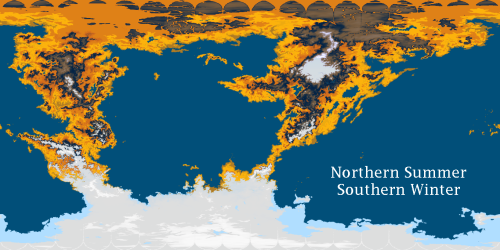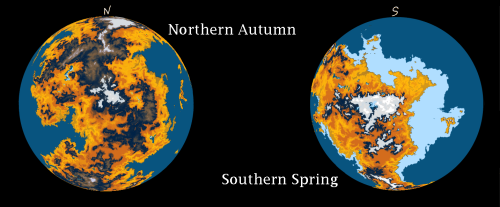These truly spectacular maps were created by @cmaidaartworkblog!Centaur HomeplanetStar: K-class, mai
These truly spectacular maps were created by @cmaidaartworkblog!Centaur HomeplanetStar: K-class, main sequencePosition from star: first Axial tilt: 51 degrees Gravity: 0.85g Terrestrial vegetation: yellow, ocherThe centaur homeplanet has extreme polar seasons because of its 51 degree axial tilt. Most of the settled regions are in the equatorial sweet spot where the sunlight is always oblique, but unlike the poles, it’s not sunless tundra for half the year and nightless desert for the other half. Enormous mountain ranges, taller than most on Earth, divide much of the continent’s interior.The recently formed megacontinent forms a continuous loop around the globe, and nomadic groups walk entire the loop every year. Nightchasers are the groups that follow the planet’s winters, entering the polar areas during their spring seasons. Sunchasers follow the planet’s summers, entering the polar areas during their autumn. The nomads mostly travel along the East Ocean’s coast, so that’s where the most geneflow happens in the settled groups. Nomads themselves are also highly variable in appearance, though they trend towards autumnal camouflage and spring camouflage. Most of the ethnicity names are derived from the names that the Shess call the other groups, since that’s where the majority of alien embassies are on the centaur homeplanet and thus where most of the Jovian English loanwords come from. Note that these are not the same as political regions– because of the clan system, centaur polities are not divided up the same way human polities are. The majority of centaurs living in space are from the nomad ethnic groups. The Shess call them Skychasers. PATREON | Runaway to the Stars -- source link
Tumblr Blog : jayrockin.tumblr.com
#jayart#rtts centaurs#aliens#speculative biology









